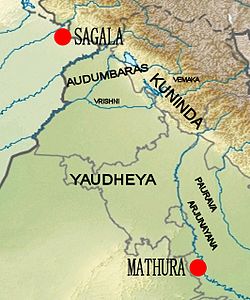
Back مملكة كونيندا Arabic Kuninda Catalan Království Kunindů Czech Royaume Kuninda French कुणिंद Hindi Regno Kuninda Italian კუნინდას სამეფო Georgian കുനിന്ദ രാജവംശം Malayalam کونند بادشاہت PNB Кунинда Russian
Kuninda Kingdom | |||||||
|---|---|---|---|---|---|---|---|
| Before 2nd century BCE–3rd century | |||||||
Silver coin of the Kuninda Kingdom, c. 1st century BCE. These coins followed the Indo-Greek module.[1]
Obv: Deer standing right, crowned by two cobras, attended by Lakshmi holding a lotus flower. Legend in Prakrit (Brahmi script, from left to right): Rajnah Kunindasya Amoghabhutisya maharajasya ("Great King Amoghabhuti, of the Kunindas"). Rev: Stupa surmounted by the Buddhist symbol triratna, and surrounded by a swastika, a "Y" symbol, and a tree in railing. Legend in Kharoshti script, from right to left: Rana Kunidasa Amoghabhutisa Maharajasa, ("Great King Amoghabhuti, of the Kunindas"). | |||||||
Location on the Kunindas and contemporary South Asian polities circa 150 CE.[2] | |||||||
 Location of Kuninda relative to other groups: the Audumbaras, the Vemakas, the Vrishnis, the Yaudheyas, the Pauravas and the Arjunayanas. | |||||||
| Government | Monarchy | ||||||
| History | |||||||
• Established | Before 2nd century BCE | ||||||
• Disestablished | 3rd century | ||||||
| |||||||
| Today part of | India Nepal | ||||||
The Kingdom of Kuninda (or Kulinda in ancient literature) was an ancient central Himalayan kingdom documented from around the 2nd century BCE to the 3rd century, located in the southern areas of modern Himachal Pradesh and far western areas of Uttarakhand in northern India and Doti Gadwall in Nepal.
- ^ "A Maharaja named Amoghabhuti, who was the Raja of the Kunindas, is known from coins of the Indo-Greek module with legends sometimes in both Brahmi and Kharoshthi, but in some cases in Brahmi only." in The History and Culture of the Indian People, Volume 2 by Ramesh Chandra Majumdar, 1951, page 161
- ^ Schwartzberg, Joseph E. (1978). A Historical atlas of South Asia. Chicago: University of Chicago Press. p. 145, map XIV.1 (d). ISBN 0226742210.
![Silver coin of the Kuninda Kingdom, c. 1st century BCE. These coins followed the Indo-Greek module.[1] Obv: Deer standing right, crowned by two cobras, attended by Lakshmi holding a lotus flower. Legend in Prakrit (Brahmi script, from left to right): Rajnah Kunindasya Amoghabhutisya maharajasya ("Great King Amoghabhuti, of the Kunindas"). Rev: Stupa surmounted by the Buddhist symbol triratna, and surrounded by a swastika, a "Y" symbol, and a tree in railing. Legend in Kharoshti script, from right to left: Rana Kunidasa Amoghabhutisa Maharajasa, ("Great King Amoghabhuti, of the Kunindas"). of Kuninda Kingdom](http://upload.wikimedia.org/wikipedia/commons/thumb/f/fa/KunindaCoin.JPG/300px-KunindaCoin.JPG)
